Over the last couple of years of travelling and documenting our journeys on our blog we have built a vibrant community of like-minded travel junkies who are as enthused about the idea of discovering more of India as we are.
Often when we are travelling through a state, locals following our journey on social media give us ideas of cool stuff they think we should check out. Many times it is these tips that usually lead to interesting offbeat and sometimes quirky discoveries.
Our trip to Korlai came about somewhat like that.
A message on Instagram with a wiki link attached cryptically suggested, ‘Check out this place you guys will like it’
The information in the Wiki link was sparse but intriguing. It spoke about a village on Maharashtra’s Konkan coast called Korlai, once part of Portuguese India, where the locals still spoke a form of Portuguese.
Korlai is infact the last place in India outside of pockets in Goa where Portuguese is still spoken and the dialect spoken here bears similarities to that spoken in Malacca, a Malaysian port which was also once under Portuguese colonial rule.
On digging further, we learnt that the Portuguese had controlled the stretch of coast from Korlai in Maharashtra to Daman in Gujarat, with its administrative capital around Bassein in Vasai, and even had a number of defensive forts in the area. The old fort in Korlai is one of them.
So when we finally planned our coastal Maharashtra roadtrip, Korlai found itself on our route. An easy driving distance from Bombay, we mapped Korlai as our first stop and made it to our homestay, SaffronStays Salt Rim, a lovely bungalow by the beach in time for lunch.

As soon as we pulled into the driveway we were greeted by Rocky, Salt Rims resident, over excited, spotted Leopard.. eerm dog. A quaint old bungalow by the beach which has dogs! What more can one ask for 🙂 Built in stone and wood on a slight slope affording a wonderful view of the beach, the bungalow itself is simple and tastefully designed. Besides the fact that the ocean is a hop and a skip (not even a jump) away, the standout feature is the long, wide balcony, with accents that reminded one of the old homes in the villages of Mumbai and Goa, perfect for evenings spent lounging, watching sunsets, sipping chai and listening to the sea.
After satiating ourselves on an excellent homemade meal of coastal style chicken, dal, veggies and Sol Kadi, and a tiny nap on an enormous four poster bed, we set out to explore the fort.
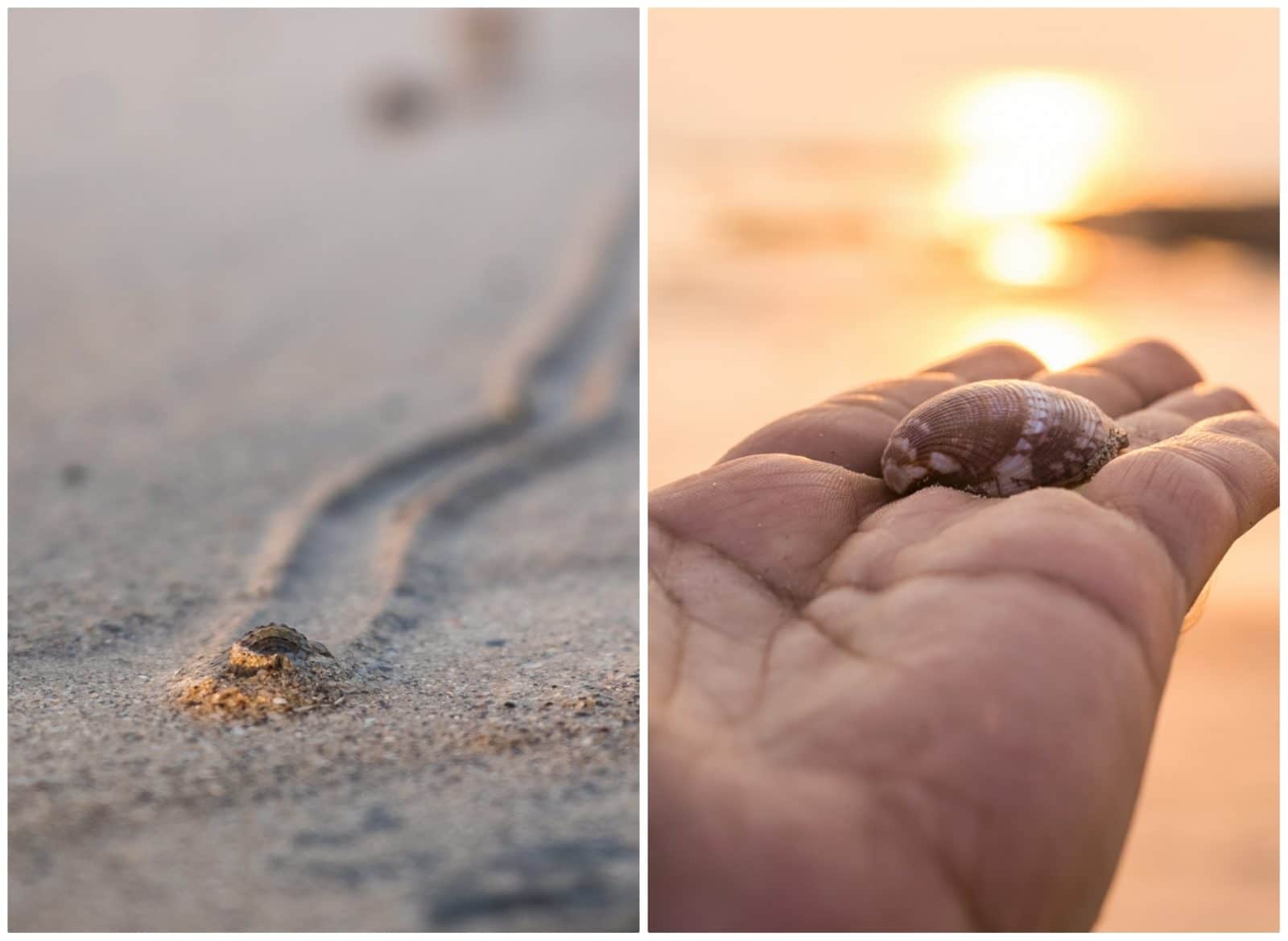
Maharashtra is strewn with forts, and the Maharashtra tourism website states that there are 350 forts in the state. Along its coast there are at least 20, small and large, and in various degrees of preservation. The fascinating part about these forts is that they were built by a wide variety of rulers from the Islamic Sultanates of Delhi, Ahmednagar and Bijapur to the Nawabs of Murud, the colonial powers of Portugal and Britain and of course the Marathas.
Build by the Portuguese to guard the Revdanda creek, the Korlai fort sits atop a small hill about 300 feet above the sea. At the southernmost reaches of the empires control, Korlai was an important fortification. And while not massive, the fort is rather impressive.
Whilst not much remains of the fort itself, it was clear that the it was once a grand structure. The Portuguese historian Diogo Do Couto in 1602 describes it as ‘a great fortress, as strong as any in the world’. Atop the fort stood a strong tower grandly known as the Castle of resistance topped by a bronze eagle with outstretched wings. The main gate was guarded by two towering bastions between which stood a great bronze lion under which an inscription declared, ‘None passes me but fights’. The fort was guarded by 70 cannons and housed a garrison of 8000 horses and soldiers, clearly demonstrating its importance.
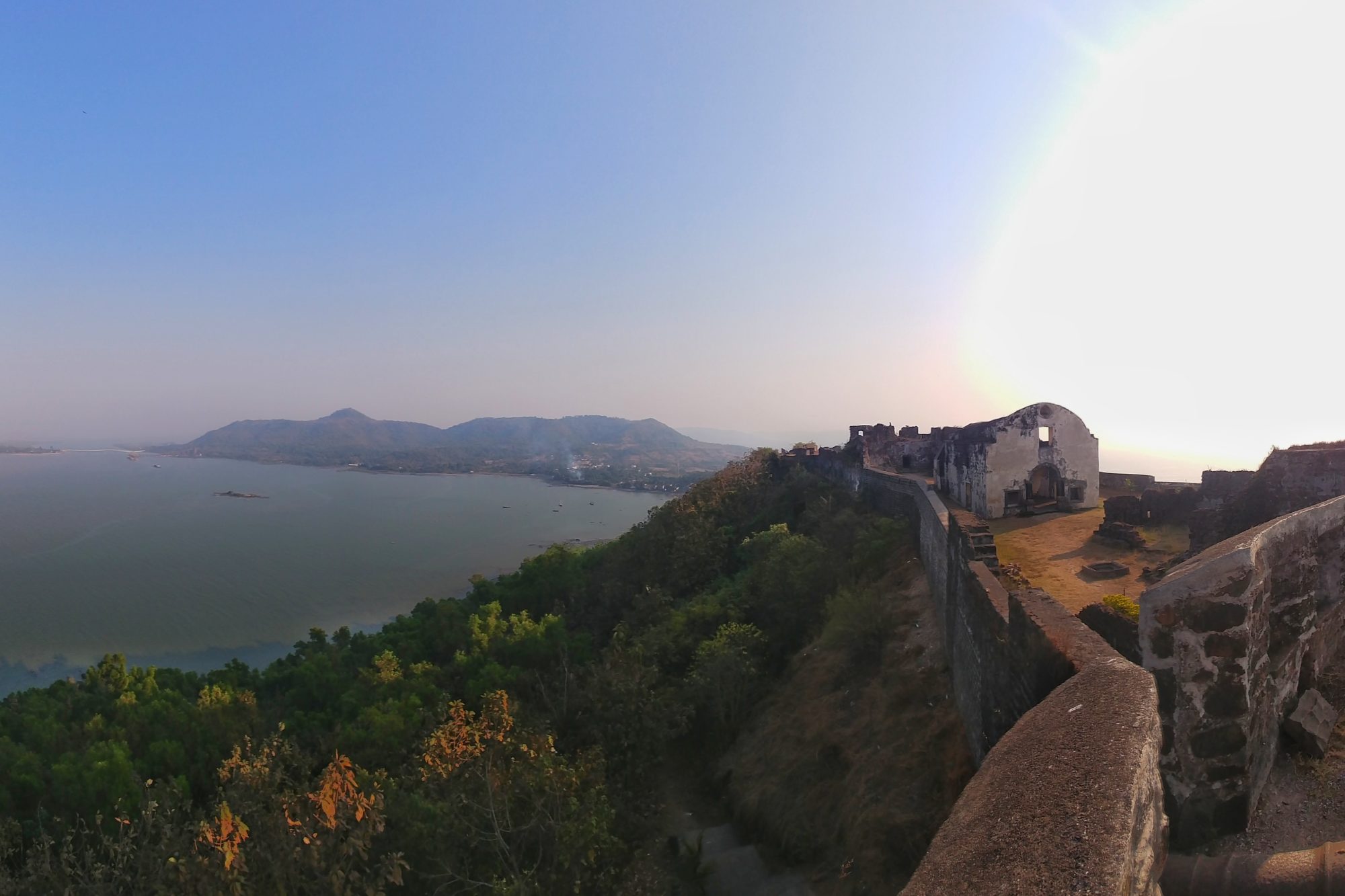
However constant skirmishes between the Islamic forces of the Ahmadnagar Sultanate and the Portuguese lead to a fair amount of destruction of the fort and by the time the Marathas gained control of Korlai in the the early 1700s, two hundred years after the original fort was built, not much of the original structure remained.
Today almost five centuries later, all that survives within the walls is the outer shell of a church, distinctly Portuguese in style, a few bastions with cannons and a couple of plaques with designs and inscriptions.
The view from the top however is still stunning. You can clearly see why the Portuguese chose this spot in Korlai to build their fortification as it offers commanding views of the Arabian ocean in the West and the Revdanda creek to the East. The best view is probably from the southernmost tip, where you can see the Arabian Sea, the river and the picturesque Korlai fishing village below.
With not another soul in sight we had the entire fort to ourselves and wandering its broken walls, the warm glow of the slowly setting sun, reflecting off the calm waters of the Revdanda creek, put us in a reflective mood.
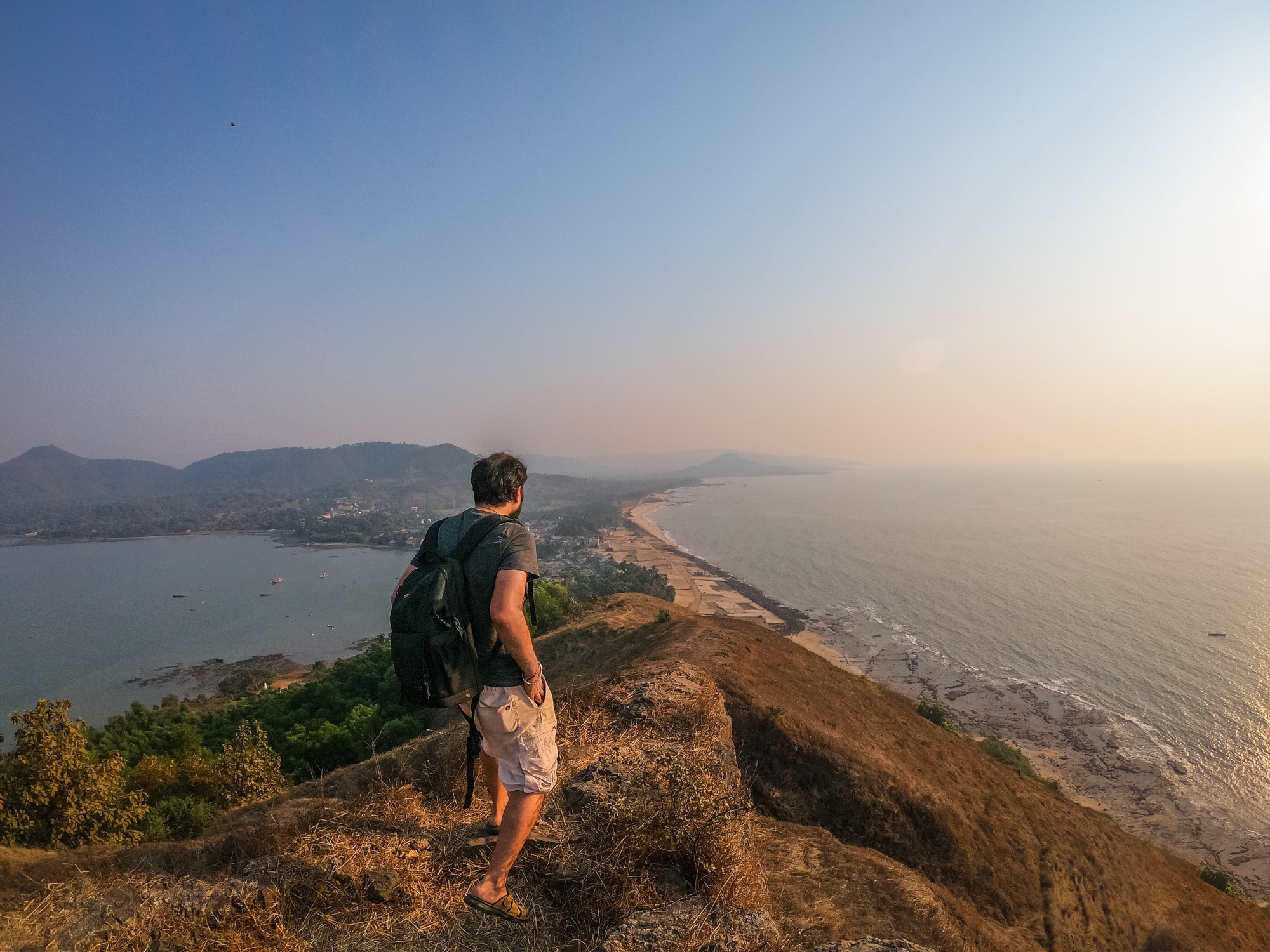
We tried to imagine what it must have been like to live in those days, a soldier of the crown so far away from home, bereft of anything familiar, constantly tussling with locals and other invaders; life would have been difficult and lonely. Which is perhaps why many of these soldiers put down roots in these faraway lands, in some cases marrying locals and setting up a new home if you will, which is where Kristi, the name given to the form of Portuguese creole spoken by the Christian inhabitants of Korlai village comes from.
After the walk down from the fort, this time though the teak forest on the eastern slope of the hill, a shorter road pointed out to us by the caretaker, we lounged around on our veranda at Salt Rim sipping on tea and watched the sky turning from orange to blue – violet hues, a nice end to the first day of our Konkan road trip.
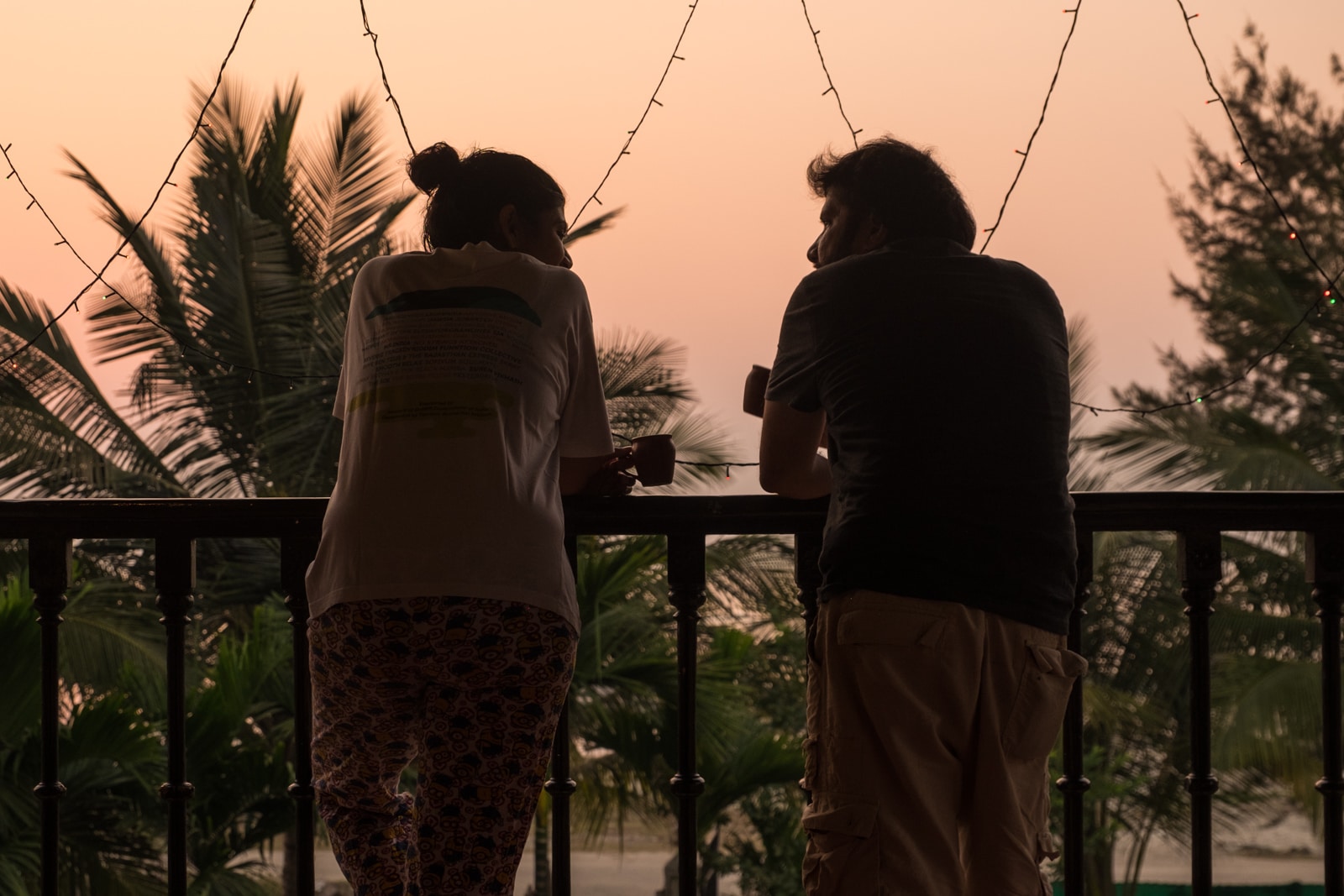
The next day we started our walk bright and early at the brightly painted orange village church, pointed out to us from the fort by the caretaker. The village is made up mainly of Christians and Kolis, and the Christians, descendants of marriages between Portuguese soldiers and locals as well as converts, live around the church.
Whilst many villages on this stretch of the coast were under Portuguese control for large periods of their 200 year odd rule, none still speak the language in any form. Korlai however is different. Isolated by the Revdanda creek till 1986 when a bridge was built connecting it to the mainland, the local Portuguese creole dialect survived, uncorrupted by the Marathi and Konkani predominantly spoken in the areas around. Infact, up until the 1960, service in the local church was also conducted in Portuguese. The church which houses a unique Portuguese era painting of the last supper, unlike any other in India, was unfortunately shut and so we made our way to the village, to find the villagers who still spoke Portuguese.
The colourful village was charming, somewhat reminiscent of the houses in villages of Goa, though nowhere near as grand. Houses were painted in greens, violets and yellows, and the street corners host small chapels. The villagers were curious but friendly, a smile returned and many wished us ‘Good morning’. I stopped outside a small home to take a photograph of a man with expressive eyes, much to the amusement of his family and neighbours, who chortle along and chatter animatedly in a language we couldn’t quite grasp. The ice broken, we strike up a conversation with the ladies around.
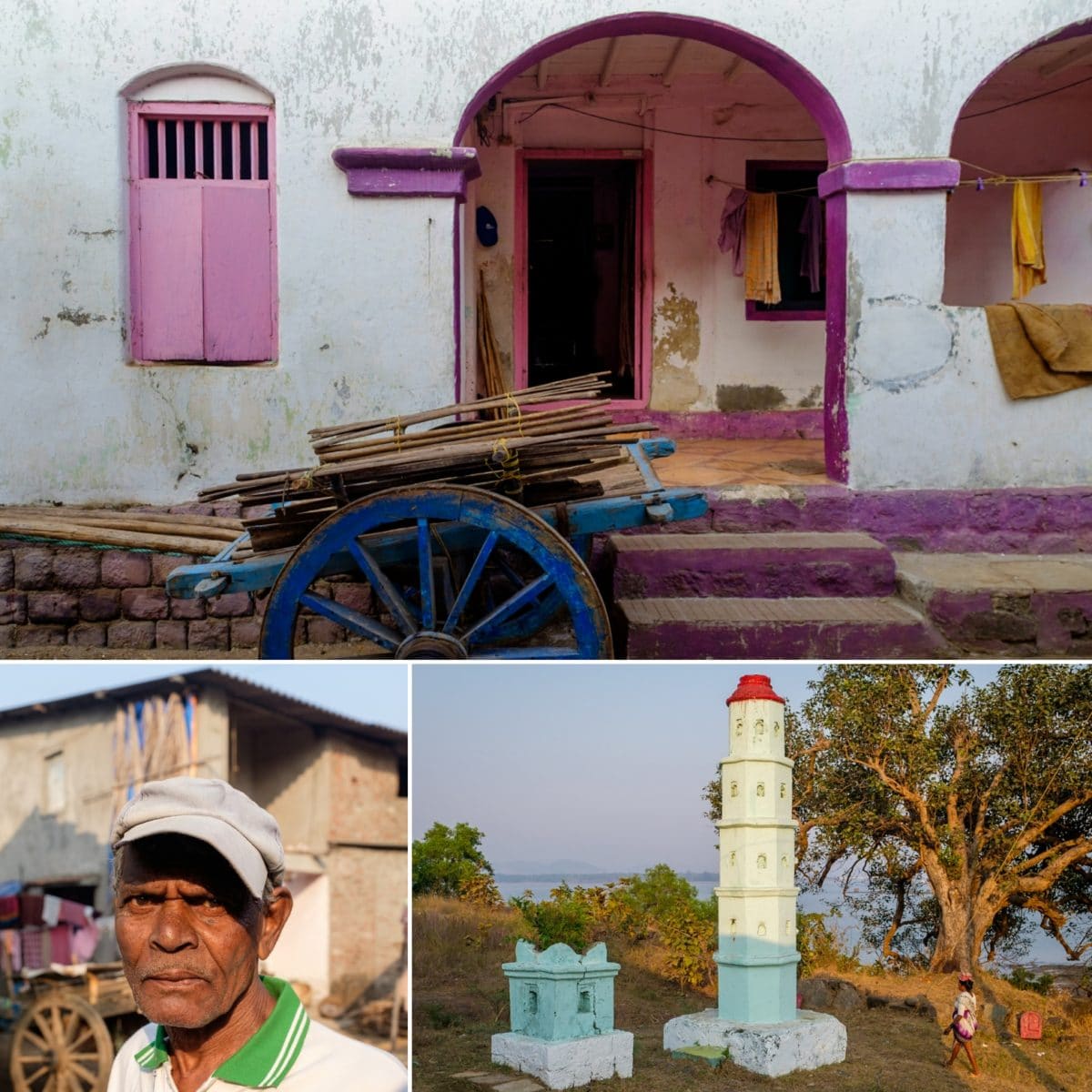
Julie started chatting with us, confirming that everyone there spoke a form of Portuguese at home, though peppered with Marathi and Konkani. Though Julie is confident that she will be understood in Portugal, unlike Goa the citizens here receive no special preference and have no path to becoming Portuguese citizens. They seem rather unaware of this opportunity and are largely unconcerned; they do not culturally associate themselves with a tiny faraway European nation.
After chatting for a while, as the kids got ready for school, we moved on, munching on berries Julie offered us from the trees in her yard. As we walked back to the homestay to continue our journey down the coast we could see the fort in the distance and wondered how long this language would survive and if indeed its got absorbed into the cultural mainstream, like so many other dialects in India and indeed around the world, wether that loss would be felt by anyone.
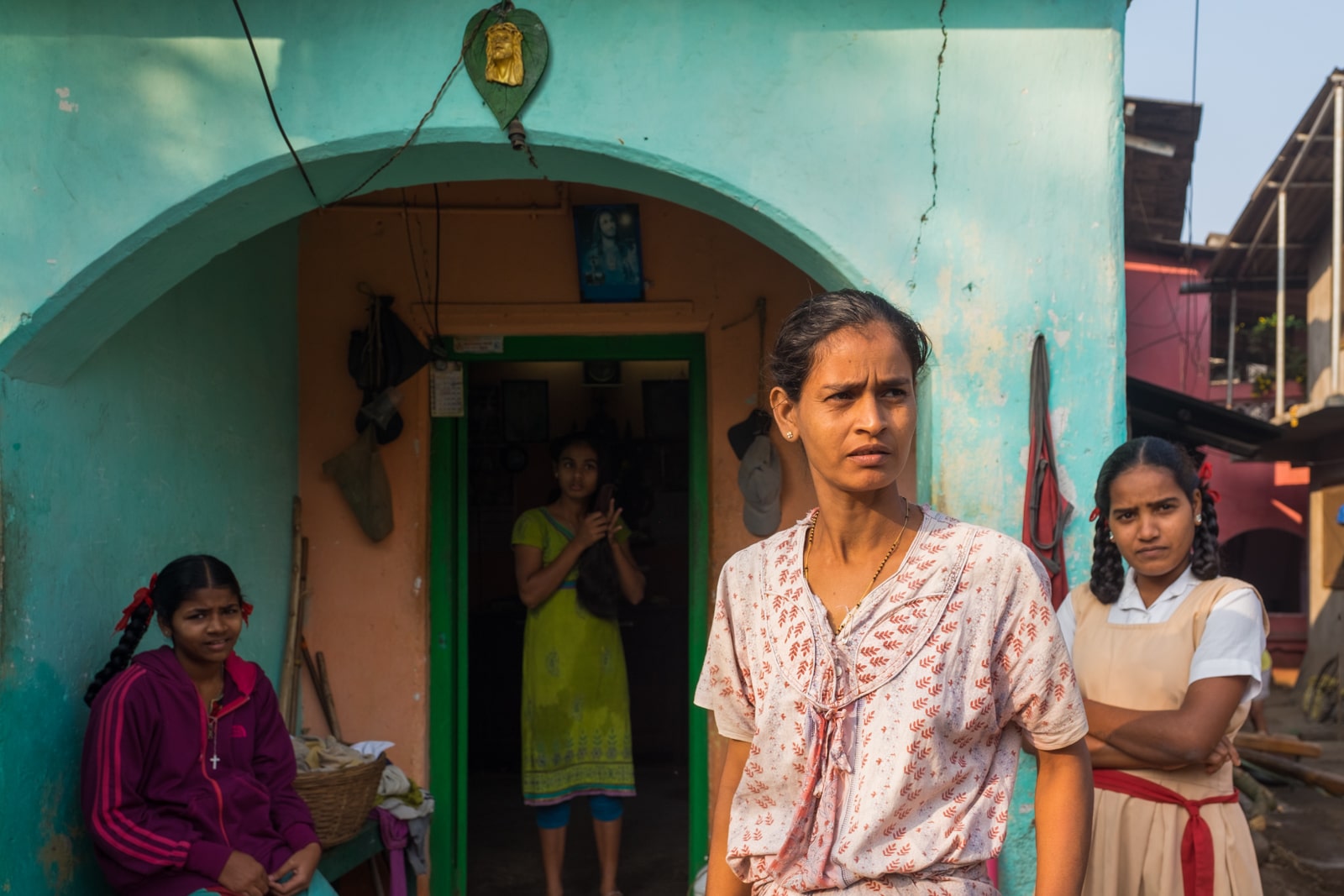
Some Useful Information:
How to get there: Korlai is located about 120 kms (approximately a 4 hour drive) from Mumbai and lies between Alibag and Kashid. The best way to get there is to drive, though there is a ferry service from Mumbai to Mandwa from where one can arrange transportation to Korlai or get a bus / share auto to Kashid beach and get off on the way.
Where to stay: Korlai does not have too many stay options which really means you have the beach all to yourself ! We stayed at SaffronStays Salt Rim a quaint heritage bungalow with two bedrooms, right on the beach and a stone’s throw away from Korlai Fort and the village. The bungalow is comfortable and nicely done up and the caretaker there will whip up a good meal on request. Perfect for a weekend break.

Dont Miss: Besides the Korlai fort and village there’s also the nearby Phansad wildlife sanctuary and Kashid beach if you feel the need to get out and explore more!
This story nudges you to just get up dit in the car and drive off. 140 kms to almost Portugal is not bad at all. Are there good restaurants that’s serve thier kind of food ..
Well written blog. I visited the Korlai village and fort for the first time some 20 years ago during my Church youth days. And today, I revisited the lovely place again. The fort is a very peaceful place and I wish it doesn’t get spoilt by too many visitors. Korlai is a quaint place undisturbed by the development all around it. I hope it stays that way!
Hi, what an interesting read! We love exploring n driving to these little treasures tucked away in our beautiful country…
Will try n follow yog on Instagram to stay in touch
Hey Rachna that’s great! Driving is one of our favourite ways to explore the countryside too 🙂 looking forward to seeing you on Instagram!
A lovely story. Would love to make a trip to Korlai
Thanks so much! Korlai is quite an interesting little place and definitely worth a weekend exploration. 🙂
Indeed very good information. Has interested in Portuguese history and Luso Indians
Thank you, glad you found it useful. 🙂
Well written! \m/
One of my favourite forts “Korlai”.
Isolated place and historical importance of the Portuguese creole of this village is a bonus!!!
My native place “Nagaon” is just nearby Korlai… 🙂
Thank you Abhishek! Totally agree! The Korlai fort location is so amazing and the Portuguese creole makes it so much more fascinating!
Wow! Korlai seems like a nice place to visit.
It is. Very under explored and a great weekend vacation spot. And the house is perfect for family and friends. Let us know what you think when you visit! 🙂
We missed joining our friends on a trip to Korlai sometime back and since then it’s been in the mind. Your story just retriggered that wish!
Did you see a prominent lighthouse closeby? Faintly remember reading of something like that.
Hi, there is a lighthouse there just below the fort, not very large but functional as far as I remember. Korlai makes for a nice little weekend jaunt from Mumbai, a good option if you are looking for something beyond the usual Alibag, Murud and Kashid.